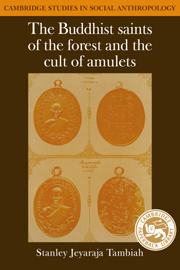Book contents
- Frontmatter
- Contents
- Acknowledgments
- Note on transcription
- 1 Introduction and manifesto
- Part I The arahant and the Path of Meditation
- 2 The Buddhist conception of the arahant
- 3 The Path of Purification: the ascetic practices
- 4 The stages and rewards of Buddhist meditation
- 5 The forest-monk tradition in Southeast Asia: a historical backdrop
- Part II The hagiography of a Buddhist saint: text and context; the politics of sectarianism
- Part III The cult of amulets: the objectification and transmission of charisma
- Part IV Conceptual and theoretical clarifications
- Notes
- Index
- CAMBRIDGE STUDIES IN SOCIAL ANTHROPOLOGY
3 - The Path of Purification: the ascetic practices
Published online by Cambridge University Press: 10 December 2009
- Frontmatter
- Contents
- Acknowledgments
- Note on transcription
- 1 Introduction and manifesto
- Part I The arahant and the Path of Meditation
- 2 The Buddhist conception of the arahant
- 3 The Path of Purification: the ascetic practices
- 4 The stages and rewards of Buddhist meditation
- 5 The forest-monk tradition in Southeast Asia: a historical backdrop
- Part II The hagiography of a Buddhist saint: text and context; the politics of sectarianism
- Part III The cult of amulets: the objectification and transmission of charisma
- Part IV Conceptual and theoretical clarifications
- Notes
- Index
- CAMBRIDGE STUDIES IN SOCIAL ANTHROPOLOGY
Summary
The Visuddhimagga, the classical Theravāda treatise on meditation, states in detail the techniques to be employed during meditation, the levels of meditative experience that are achieved, and the pitfalls and triumphs that await the practitioner. This classic has been a principal guide for Buddhist meditators down the ages and constitutes a major point of reference in our study of present-day Thai meditation masters and forest saints.
The Visuddhimagga, the work composed by Buddhaghosa in the fifth century A.D., contains a summary and interpretation of the basic teachings of the Buddha contained in the Pali Tipiṭaka rendered according to the “abhidhamma method.” Ñāṇamoli calls it “the principal non-canonical authority of the Theravāda”; it is at the same time “a detailed manual for meditation masters” and a “work of reference.” It was composed during the epoch of renascence in Pali studies after a period of decline in literary activity in the early centuries in Ceylon and South India. This period of decline corresponded with the ascendance of Sanskrit composition in Indian Buddhism. By A.D. 400, the time was ripe for a Pali recension of the Sinhalese commentaries, and Buddhaghosa, coming to Ceylon from India, was apparently the instrument of this Pali renascence.
The legend concerning the test imposed on Buddhaghosa by the Sinhalese Elders and the manner in which the Visuddhimagga was composed indicate its doctrines and teachings are genuinely pristine and have been transmitted without corruption and that the sangha's ordination lineage has had an unsullied continuity through time.
- Type
- Chapter
- Information
- Publisher: Cambridge University PressPrint publication year: 1984

